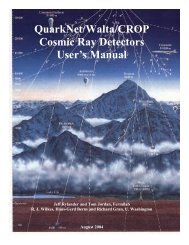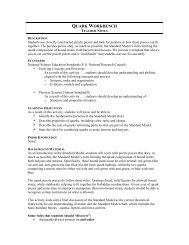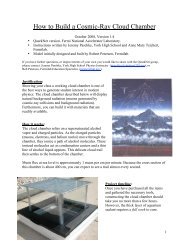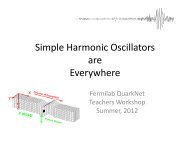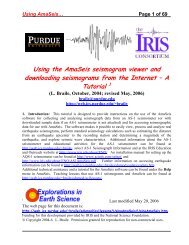Teaching Modern Physics - QuarkNet - Fermilab
Teaching Modern Physics - QuarkNet - Fermilab
Teaching Modern Physics - QuarkNet - Fermilab
You also want an ePaper? Increase the reach of your titles
YUMPU automatically turns print PDFs into web optimized ePapers that Google loves.
periodicals and newsletters. The collection also includes reports on science and<br />
mathematics education, standards, assessment, equity and other topics. Visitors also have<br />
access to Internet resources. TRC services include professional development workshops,<br />
consultation assistance available upon request, a periodical holding list, bibliographies<br />
and telephone reference. A U.S. Department of Education Eisenhower National<br />
Clearinghouse Demonstration Site is located in the TRC. . . . Staff is available to assist<br />
science, mathematics and technology educators with curriculum and instruction issues.”<br />
<strong>Physics</strong> Data<br />
Investigate Special Relativity<br />
“This Website provides resources for secondary and post-secondary teachers of physical<br />
science. These resources include data reduction projects and particle physics data files.<br />
The data reduction projects guide student investigation of a dataset to a particular end<br />
result. The data files are written in a format that allows for rapid Web file transfer and<br />
ease of import into commonly available applications such as Microsoft Excel. Students<br />
download and reduce these data in an open-ended environment in which they investigate<br />
their own questions. The first of these resources is a data reduction project that guides<br />
students to an understanding of special relativity.” (Description taken from <strong>Fermilab</strong><br />
website)<br />
Calculate the Top Quark Mass<br />
“This classroom activity is available online or as part of the Topics in <strong>Modern</strong> <strong>Physics</strong><br />
revised teachers guide. Students use data from a special top quark event and conservation<br />
of momentum to calculate the mass of the top quark. The activity builds on an<br />
understanding of vector addition, and the instruction needs to add only a short<br />
explanation of particle physics.” (Description taken from <strong>Fermilab</strong> website)<br />
Study Cosmic Rays with Student-Collected Data<br />
The cosmic ray e-Lab allows users to search for data from more than 120 cosmic ray<br />
detectors located in high schools across the world. These small detectors observe the<br />
ground-level signature of particles that constantly bombard Earth’s upper atmosphere.<br />
Analyzing the data can answer such questions as “Where do these things come from?” or<br />
“How often do they arrive?” or “How long do they last? Students can share the results of<br />
their analysis by publishing an e-Lab poster. The web document also allows other<br />
students to ask questions or leave comments on the poster.<br />
Search for the Higgs Activity<br />
These web pages invite visitors to join in the hunt for evidence of the Higgs particle. This<br />
boson will allow us to understand the process by which particles attain their mass.<br />
Accelerators are approaching the energy needed to create these. The detector teams must<br />
create plans for what signature a Higgs will leave behind. The web pages offer data in<br />
Excel spreadsheets suitable for downloading. Visitors can analyze these data and look for<br />
patterns that might indicate evidence for the Higgs.<br />
184




